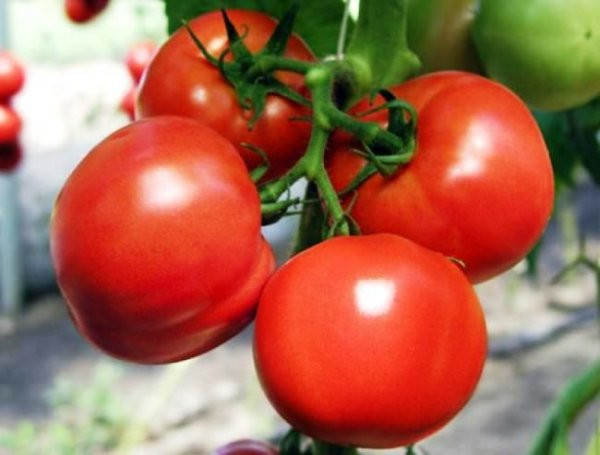 Connoisseurs of rare foreign varieties will like the tomato Dularrigin. This variety has several advantages, including the perfect shape of the tomato and their unusually juicy bright taste.
Connoisseurs of rare foreign varieties will like the tomato Dularrigin. This variety has several advantages, including the perfect shape of the tomato and their unusually juicy bright taste.
Content
Grade characteristics
Dularigin is a mid-early, unpretentious variety of Chinese selection. Fruits reach technical ripeness by 115 days, reach biological maturity by 130. The variety is characterized by early and simultaneous ripening of fruits.
Determinant type plants. The height of the bushes reaches 90-100 centimeters. In some cases, support is required. Bushes of medium leafy. The foliage is dark green, fine, smooth. Brushes are tied without gaps. On each branch, up to ten small juicy fruits are formed.
The tomatoes themselves Dularigin variety in full ripening have a bright red color, they are rounded in shape, slightly flattened on top. The fruits are quite large, the weight of a single specimen of medium size is 150 grams (sometimes it reaches 300 grams).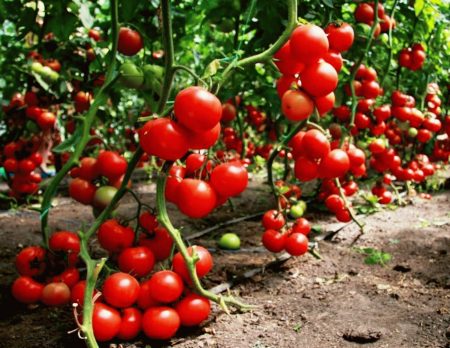
The skin is thin, but dense, glossy. The pulp is juicy, slightly sweet, porous. The number of seed chambers is 4. Rich taste with a slight acidity and bright aroma. The purpose of the variety is canning and home cooking.
Dularigin is a high-yielding variety. From one square meter, up to 8-9 kilograms of selected high-quality fruits are collected. Tomatoes of this variety are distinguished by high keeping quality, good transportability.
This Chinese tomato variety can be grown in any way, but in the northern regions it is preferable to plant Dularrigin in a greenhouse. In the south of the country a seedling method of cultivation is possible.
The variety tolerates a short-term temperature drop quite well (up to three hours). With frequent temperature differences, the bushes are very affected - they poorly form ovaries, take off flowers and die.
Dularidzhin plants are resistant to a number of diseases, such as verticillosis, fusarium and root rot. Virtually no late blight.
In general, the Dularidzhin variety is a persistent, unpretentious and reliable tomato variety that always gives a good harvest, and its fruits have excellent external and taste data.
Grade Advantages:
- high productivity;
- universality of use;
- grows well under different growing conditions;
- fruits are all the same shape, optimal for whole-canning;
- tomatoes are well stored and are not damaged during transportation;
- plants are protected from many diseases.
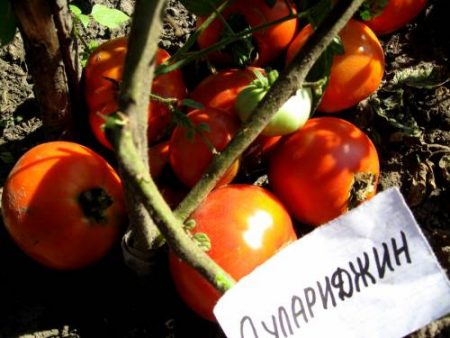
Features of growing tomato Dularrigin
Dularigin in our country is not sown immediately in the ground, but grown in seedlings. Planting of seeds is carried out in mid-March - at a time when daylight hours are already gaining momentum, and seedlings will develop better. The first brushes will appear in April or early May.
The first shoots will hatch in 10 days. They intensively develop at temperatures up to +22 degrees (+16 at night), in a warm and well-lit place. In order for the stems to stretch upward and not to thin out, you must carefully observe the solar regime - if there is not enough daylight, then you need to highlight the seedlings artificially.
It is important to grow seedlings in earth enriched with minerals. The soil should be soft, warm, airy, well-drained. Drainage can be achieved by adding peat or river sand to the ground.And so that the plants grow the vegetative mass quite actively, humus is added to the soil. Organics allows plants to feed throughout seedlings.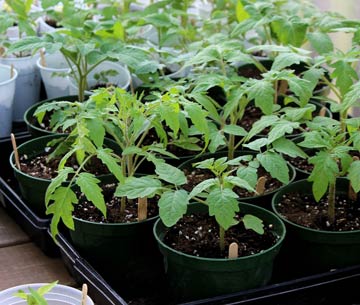
Very soon (3 weeks will pass) the sprouts will take on the appearance of a bush. The first leaves will bloom on them. At this time, it is necessary to carry out the resettlement of young shoots in separate containers, since in one box it becomes crowded. Dive is carried out very carefully, carefully removing seedlings from the ground with a small spoon and trying not to touch the seedlings. The root system of the tomato at the initial stage is quite fragile and any mechanical impact can damage it. Sick roots take root in a new earth for a very long time, and sometimes they can die at all. In the first days after a dive, the cuttings may look tired and sick, and their leaves fade. This is a natural process of adapting to a new land. After a while, the plants will regain their juiciness and stand in orderly rows.
A few days after transplanting, young seedlings need to be nourished, since from this moment rapid growth begins. You can use complex minerals.
You need to water the seedlings regularly, while controlling the level of humidity of the earth. If it is too wet, you need to arrange ventilation.
Tomatoes are planted at the age of 65 days. Only healthy seedlings are suitable for planting: plants should be juicy, dark green, have a strong stem, without signs of rot and damage.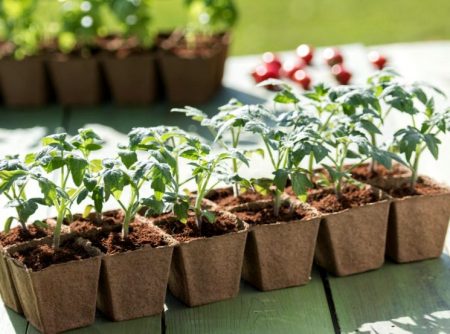
Overgrowth of seedlings should not be allowed when flowering has already appeared on the bushes. Such plants are poorly transplanted.
Landing
When the seedlings rise by 25 centimeters, and the cold ends on the street, there comes an opportune moment for transplanting the seedlings into the garden. Do not rush into planting: if the earth does not get warm enough, the roots will simply freeze and the plants will die. In addition, young shoots are very sensitive to frost. Therefore, when growing in unprotected soil, you should think about temporary shelters for tomato beds.
For tomatoes, only fertile soil enriched with organic and mineral substances is suitable. Therefore, when planting beds, it is necessary to introduce humus, superphosphate. Or use complex supplements.
At the bottom of the holes you can put a couple of spoons of wood ash. Before planting, the land is abundantly watered and a seedling is placed in the ground. Seedlings need to be transferred to the hole by the method of transshipment, that is, with a lump of earth at the root.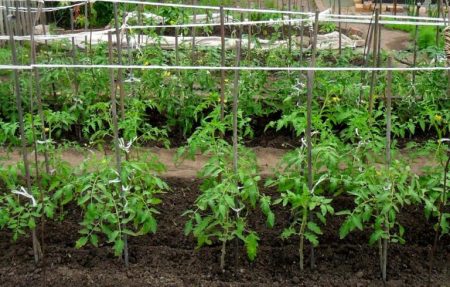
From above, the seedling is sprinkled with earth, rammed it a little and watered again.
Determinant plants are best planted in rows, be sure to observe a distance between the bushes of 40-50 centimeters. Between the rows it is recommended to leave 60-70 centimeters.
Care
Tomato care includes such agricultural practices as:
- watering;
- top dressing;
- soil cultivation (loosening, hilling, mulching);
- tying up;
- treatment from pests and diseases.
Plant formation
Growing varieties Dularigin has its own characteristics. It seems to many gardeners that there is no need to form plants, and if there is, it is very difficult to do. However, as practice shows, it is imperative to form plants that the yield is somewhat larger, and the quality of the fruits is at the highest level. The described variety brings a crop much higher if you form it in two stems.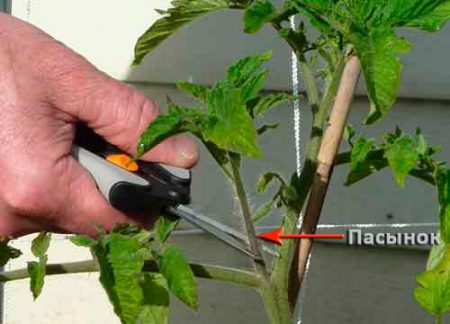
The formation of plants affects the ripening time.Removing unnecessary stepsons leads to a redistribution of nutrition of all parts of the plant. Now all the nutrients will go directly to the fruit, and not to unnecessary branches.
Stepsons appear from the places of articulation of leaves, where he leaves the stem. Lateral shoots begin to form after the first or second inflorescence. With growth, the stepson turns into a stalk, which in turn also forms leaves and its stepsons. This process is endless, it leads to thickening of plantings, delays the ripening of fruits, and the tomatoes themselves grow small and not juicy. Therefore, once a week you need to break off the stepsons. When forming bushes in two stems, all stepsons are removed, leaving only the central trunk and one additional shoot, which is located at the leaf under the first inflorescence. It will eventually turn into the same sturdy stalk. Brushes will form on it that will bear fruit.
Watering
In the first 10 days after transplanting seedlings to the beds, it is not necessary to pay too much attention to young seedlings. They need time for a calm and painless acclimatization. After the plants regain a healthy appearance and get stronger, it is possible to carry out agricultural practices.
Tomatoes love rare but plentiful watering. Each bush on average needs up to 3 liters of water daily. Watering should only be done under the root in order to avoid moistening the leaves, which can eventually rot or pick up some disease.
Watering should be done in the early morning or late afternoon so that the moisture does not evaporate longer.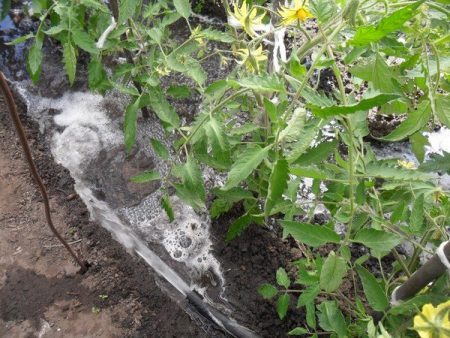
In dry periods, watering should be done 3 times a week, on cloudy days - 1 time in 6 days.
Tillage
The soil under the bushes should be loose, light, airy. So that it does not condense from watering, it must be loosened regularly. Shaking the ground promotes better gas and water exchange between the depths of the soil and the surface. In addition, if the earth is constantly dry up, then waterlogged, the roots will develop worse, and the tomatoes will grow small and tasteless.
If the bushes are very long, you can spud them around the stem. So the bush will become more stable and will not break.
Topping Tomatoes
An important component of the successful cultivation of tomatoes Dularigin is the timely application of fertilizers throughout the period of cultivation of tomatoes. Fertilizing bushes with organic and mineral components contributes to the earlier appearance of fruits and their rapid ripening. In addition, if a plant eats well, it is less likely to get sick and tolerates all climatic changes quite calmly.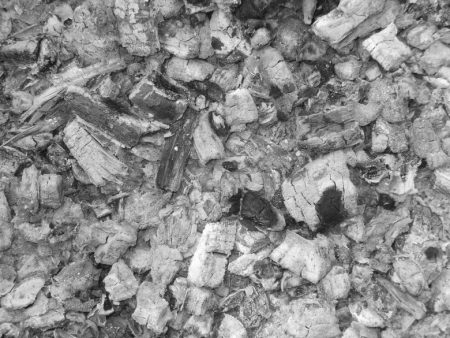
For the first time, tomato bushes are fed two weeks after planting on the bed, when the seedlings take root and get stronger. For further intensive growth, they need food. To build vegetative mass, tomatoes need organic matter in the form of rotted manure and nitrogen.
During flowering, tomatoes need to be nourished with infusion of mullein, chicken manure, with the addition of wood ash and superphosphate. With the advent of ovaries, the amount of minerals increases, lowering the nitrogen norm in the compositions, since from the moment of fruiting the plant needs more potassium and phosphorus for the rapid creation of fruits and their filling.
Root dressing can be combined with liquid (through the leaf), which tomatoes are very well absorbed. Good recharge with the use of iodine and serum. Tomatoes processed with this composition ripen faster and are less susceptible to diseases and pests.
Reviews
Michael
Great variety. Tomatoes grew well in humid and cool summers.They were not sick with anything, even the aphids did not sit on them. All they did was feed, weed. Watering was not particularly necessary, as there were frequent rains. As a result, Dularidzhin gave a very good harvest, while the neighboring beds with other varieties really did not tie anything. In general, I am glad that I tried this variety. I recommend.
Helena
We have been growing Dularigin on our site for several years. Very good grade. I like these tomatoes - and apparently they are not big and not small, very fleshy, juicy, sweet. In salads, salts, soups, their rich taste is very well manifested. The good news is that almost a bucket of tomatoes comes out of one bush. Very good crop grade. It tolerates hot days and cold snap, though I always cover it with film during the cool. For us, this is the perfect variety: unpretentious, productive and reliable. With him, I always know that I won’t stay without a tomato anyway.
Catherine
I tried to plant a variety of Dularidzhin Chinese breeding. Yes, the variety is really very good, I did not notice any cons. Planted in a greenhouse. The bushes grew a little over a meter tall, tied them to a support. She formed bushes in 2 stems. In July, the brushes began to bear fruit. Just an amazing sight - all the bushes are covered with placers of red tomatoes that matured very quickly, the main thing is friendly. I do not like it when the fruits are sung gradually and very slowly. And then the whole crop at a time. This suits me, since the time comes for pickles, and I can not wait for the other tomatoes to ripen. Tomatoes taste sweet and sour. Very pleasant aroma. There are not many seeds. In general, a very decent variety.




 Low-growing tomatoes, without pinching: 5 of the most delicious varieties
Low-growing tomatoes, without pinching: 5 of the most delicious varieties Why tomato seedlings grow poorly
Why tomato seedlings grow poorly We grow a tomato in a shell
We grow a tomato in a shell Growing tomatoes without watering according to the method of Kazarin
Growing tomatoes without watering according to the method of Kazarin